Hugo Colorado — A Proud History – Proud Future
Hugo Colorado, prior to 1859, was inhabited primarily by Cheyenne and Arapahoe Indians and buffalo. Numerous arrowheads and other artifacts can still be found in the hills around Hugo. 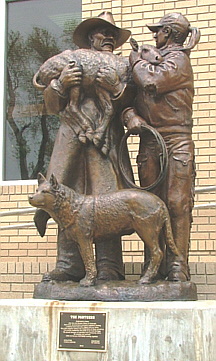 The discovery of gold in the Colorado Mountains brought large cattle ranching operations to this area to help supply meat to miners. As miners and other business people moved west there was a need for transportation. The stagecoach filled that bill for a number of years and Hugo was the site of a stagecoach stop for the Butterfield Overland Dispatch. That stop was called the Willow Springs Stop and it was located at the southeast corner of the current Lincoln County Fair Grounds. Ulysses S. Grant came through Hugo by Stagecoach before he became president. In addition the Smoky Hill Trail came through here and some of the original tracks can still be seen just to the north of Hugo. By the late 1800s and into the early 1900s homesteaders flooded into the state. Some lived in tar paper shacks and others lived in sod buildings. Some came by covered wagon, some on foot, some on horse-back and later some by stagecoach and eventually by train. These are the hardy souls that are the forefathers of our community.
The discovery of gold in the Colorado Mountains brought large cattle ranching operations to this area to help supply meat to miners. As miners and other business people moved west there was a need for transportation. The stagecoach filled that bill for a number of years and Hugo was the site of a stagecoach stop for the Butterfield Overland Dispatch. That stop was called the Willow Springs Stop and it was located at the southeast corner of the current Lincoln County Fair Grounds. Ulysses S. Grant came through Hugo by Stagecoach before he became president. In addition the Smoky Hill Trail came through here and some of the original tracks can still be seen just to the north of Hugo. By the late 1800s and into the early 1900s homesteaders flooded into the state. Some lived in tar paper shacks and others lived in sod buildings. Some came by covered wagon, some on foot, some on horse-back and later some by stagecoach and eventually by train. These are the hardy souls that are the forefathers of our community.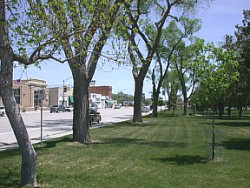 In 1870 the Kansas-Pacific Railroad came through, and a small town grew up around the K-P watering stop. In 1889 Hugo became the county seat of government for the newly created Lincoln County, and twenty years later the town was incorporated. For many years the railroad and ranches provided the primary income for the town. Cattle were shipped out of Hugo by rail until the early 1960s. Wheat and other grains are still shipped by rail during harvest, but mostly the rails through Hugo carry coal today.
In 1870 the Kansas-Pacific Railroad came through, and a small town grew up around the K-P watering stop. In 1889 Hugo became the county seat of government for the newly created Lincoln County, and twenty years later the town was incorporated. For many years the railroad and ranches provided the primary income for the town. Cattle were shipped out of Hugo by rail until the early 1960s. Wheat and other grains are still shipped by rail during harvest, but mostly the rails through Hugo carry coal today. 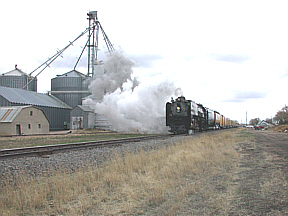 That coal is from Wyoming in route to Kansas to generate electricity for the western United States. The days of passenger trains are over but in their time they brought some famous people to Hugo. President Harry Truman has been here by rail as well as Teddy Roosevelt and Franklin Delano Roosevelt when he was running for election the first time and again in 1943. When the Depression hit the United States in the 1930s, Hugo played a role in the recovery. The location is not certain, but west of the Hugo School was a CCC Camp (Civilian Conservation Corps). (The school ground may have been part of the camp or all of it.) Its motto was “Save the Soil, Save the Forests, Save the Young Men” and the young men worked on a variety of conservation projects. Many of today’s farmers and ranchers can still see results of CCC terracing and dam building. Other projects of social significance still exist as well. The swimming pool in Hugo is a prime example. Hugo is a patriotic community. We have sent our young men and women to war in every conflict undertaken by the U.S. Government since our inception. In the middle of our city park is a memorial to those who lost their lives in WW I. Our VFW is named after a local boy, Joe Will, who was killed in the bombing of Pearl Harbor. We still salute the flag, say grace at public gatherings and respect the rights of everyone.
That coal is from Wyoming in route to Kansas to generate electricity for the western United States. The days of passenger trains are over but in their time they brought some famous people to Hugo. President Harry Truman has been here by rail as well as Teddy Roosevelt and Franklin Delano Roosevelt when he was running for election the first time and again in 1943. When the Depression hit the United States in the 1930s, Hugo played a role in the recovery. The location is not certain, but west of the Hugo School was a CCC Camp (Civilian Conservation Corps). (The school ground may have been part of the camp or all of it.) Its motto was “Save the Soil, Save the Forests, Save the Young Men” and the young men worked on a variety of conservation projects. Many of today’s farmers and ranchers can still see results of CCC terracing and dam building. Other projects of social significance still exist as well. The swimming pool in Hugo is a prime example. Hugo is a patriotic community. We have sent our young men and women to war in every conflict undertaken by the U.S. Government since our inception. In the middle of our city park is a memorial to those who lost their lives in WW I. Our VFW is named after a local boy, Joe Will, who was killed in the bombing of Pearl Harbor. We still salute the flag, say grace at public gatherings and respect the rights of everyone. 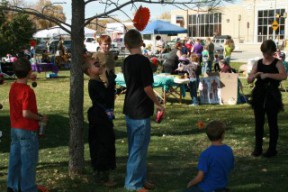 Hugo is a great place to live. We have a great school, a super hospital, top notch senior care facilities for those who cannot get out and around, but most of all we have a positive attitude. Hugo is a place where a little grassy park in the center of town welcomes all who need a shady rest or a spot to relax. Rest assured that when you are in Hugo you are welcome and we are glad to have you here.
Hugo is a great place to live. We have a great school, a super hospital, top notch senior care facilities for those who cannot get out and around, but most of all we have a positive attitude. Hugo is a place where a little grassy park in the center of town welcomes all who need a shady rest or a spot to relax. Rest assured that when you are in Hugo you are welcome and we are glad to have you here.
 Other spots to explore before you leave Hugo Colorado include:
Other spots to explore before you leave Hugo Colorado include:
The Hugo Union Pacific Roundhouse (located on the northwest side of Hugo Colorado)
No On-Site tours are available during reconstruction. Originally constructed in 1909, the Hugo Union Pacific Railroad Roundhouse is one of only three remaining from the original pre-merger Union Pacific Railroad, with this being the only one in Colorado. 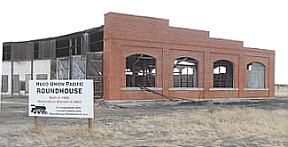 It’s one of only four historic roundhouses left in Colorado and the only one associated with the Union Pacific Railroad. It’s also the only surviving brick roundhouse in the state and one of the most significant historical sites on Colorado’s Central Plains. For more information visit this website.
It’s one of only four historic roundhouses left in Colorado and the only one associated with the Union Pacific Railroad. It’s also the only surviving brick roundhouse in the state and one of the most significant historical sites on Colorado’s Central Plains. For more information visit this website.
Visit the Hedlund House Museum to see the stories behind the history.
The Hedlund House Museum located on the SW corner of 4th Ave and 7th St in Hugo. 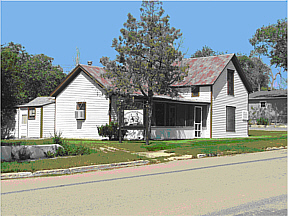 Nearly a century and a half have passed since William A. Hill, a Civil War veteran from Massachusetts, arrived on this spot. In those days, cattle comprised the only local industry, and this undeveloped land rested along the stage line between the Willow Springs and Lake stations. Mr. Hill and his partner operated a general store and trading post, serving the new rail line constructed by the Kansas Pacific Railway Co. in 1870. Mr. Hill filed his homestead claim in 1875 and platted the town that ultimately came to be called “Hugo.” In 1877, Mr. Hill built this house, and lived in it for nine years. Gip Beasley made his home here for two years, until Mr. Hill moved his family back in, in 1889. Over the next 18 years, residents of this house included Frank Tompkins (four years), John C. Wilson (six years), L. D. Rockey (five years), and James Dostal (four years). In 1918, the Peter O. Hedlund family assumed ownership of the house, and for the next 53 years, it was home to three generations of Hedlunds. In 1971, Mertle C. Hedlund donated the home and property to the Town of Hugo. It was her desire that the house should become a museum. The town gratefully accepted Mrs. Hedlund’s gift. In August of 1972, Lincoln County dedicated the Hedlund House Museum. Items continue to be donated for display in the museum, and the Town has erected another display building just north of the Hedlund House. While the Town of Hugo pays for maintenance, the museum is staffed entirely by volunteers. Thousands of people have toured the Hedlund House over the past three decades.
Nearly a century and a half have passed since William A. Hill, a Civil War veteran from Massachusetts, arrived on this spot. In those days, cattle comprised the only local industry, and this undeveloped land rested along the stage line between the Willow Springs and Lake stations. Mr. Hill and his partner operated a general store and trading post, serving the new rail line constructed by the Kansas Pacific Railway Co. in 1870. Mr. Hill filed his homestead claim in 1875 and platted the town that ultimately came to be called “Hugo.” In 1877, Mr. Hill built this house, and lived in it for nine years. Gip Beasley made his home here for two years, until Mr. Hill moved his family back in, in 1889. Over the next 18 years, residents of this house included Frank Tompkins (four years), John C. Wilson (six years), L. D. Rockey (five years), and James Dostal (four years). In 1918, the Peter O. Hedlund family assumed ownership of the house, and for the next 53 years, it was home to three generations of Hedlunds. In 1971, Mertle C. Hedlund donated the home and property to the Town of Hugo. It was her desire that the house should become a museum. The town gratefully accepted Mrs. Hedlund’s gift. In August of 1972, Lincoln County dedicated the Hedlund House Museum. Items continue to be donated for display in the museum, and the Town has erected another display building just north of the Hedlund House. While the Town of Hugo pays for maintenance, the museum is staffed entirely by volunteers. Thousands of people have toured the Hedlund House over the past three decades.
The Hugo Rail Depot
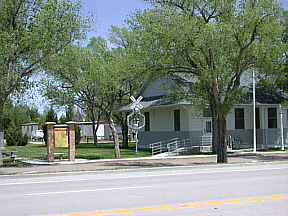 This building is the actual Union Pacific passenger depot. It was originally located along the Union Pacific tracks but is now located along Main Street. The depot has been completely restored and is used for various community events like the annual Christmas Tree walk, family reunions, and even a wedding or two.
This building is the actual Union Pacific passenger depot. It was originally located along the Union Pacific tracks but is now located along Main Street. The depot has been completely restored and is used for various community events like the annual Christmas Tree walk, family reunions, and even a wedding or two.
